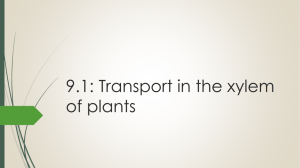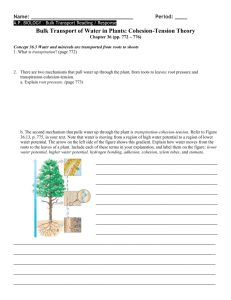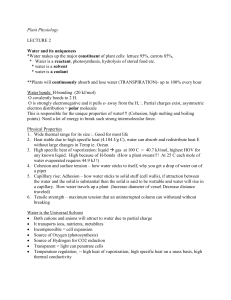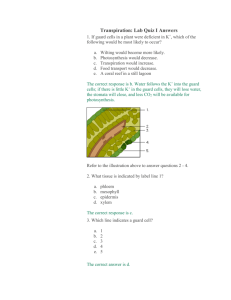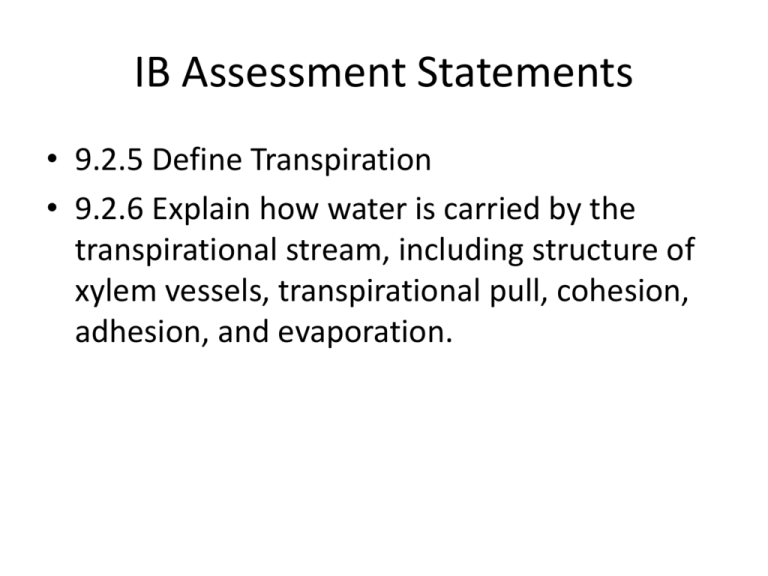
IB Assessment Statements
• 9.2.5 Define Transpiration
• 9.2.6 Explain how water is carried by the
transpirational stream, including structure of
xylem vessels, transpirational pull, cohesion,
adhesion, and evaporation.
Transpiration
Transpiration is the loss of water form
the leaves and stem of plants.
Pathway of Water in Plant Transport
1. Soil ---> Epidermis of Roots Hair Cell
2. Epidermis of Roots Hair Cell Cortex Cells
3. Cortex Cell - Endodermis Cells (with a
Casparian strip)
4. Endodermis Cells Vascular Tissue (xylem
Cells)
5. Xylem Cells Leaves
6. Leaves Stomata or Leaves to chloroplasts
Root Functions
1. Soil ---> Epidermis
of Roots Hair Cell
• The high concentration of mineral ions in the
plant cells causes water molecules to move into
the plant by osmosis.
Cortex cells
Epidermis
root hairs
Copyright Pearson Prentice Hall
2. Epidermis of Roots Hair Cell Cortex Cells
Water movement across the cortex cell is by two pathways both
involving a water potential gradient.
1. The cortex cell cytoplasm has a solute concentration
gradient. This moves water symplastically from cell to cell by
osmosis (b,c,d,h in above diagram).
2. The Apoplastic pathway moves water by capillary action of
mass flow through the connecting cellulose cell wall (e, f in
above diagram)
3.Cortex Cell - Endodermis Cells (with a Casparian
Root Functions
strip)
• Endodermis cells are surrounded on four sides
by a waterproof strip called a Casparian strip.
Cortex Cells
Endodermis
Casparian
strip
Copyright Pearson Prentice Hall
Casparian strip
3.Cortex Cell - Endodermis Cells (with a
Casparian strip)
• The casparian strip of the
endodermis is a barrier to
the movement of water of
minerals by the apoplastic
pathway.
• All solute and water must
move through the plasma
membrane of the
endodermal cells before
entering the xylem.
4.Endodermis Cells Vascular Tissue (xylem
Cells)
• The cellulose cell wall of the endodermis
contains a strip (casparian strip) of a
waxy water repellant substance called
suberin.
• The suberin prevents water and dissolved
minerals from passing into the xylem by
the apoplastic pathway.
• Therefore water solution must pass
through the plasma membrane of the
endodermis. The endodermis plasma
membrane can then selectively control
mineral uptake and rate of uptake.
• Minerals are actively loaded into the
xylem which in turn causes water to enter
the xylem vessel via osmosis.
• Pressure within the xylem increases
forcing water upward (Root Pressure).
This is probably not a major factor in
transpiration of large plants.
5. Xylem Cells Leaves
Xylem Facts
• Xylem vessels form a continuous
pipe from the root up through the
stem along petioles to the leaf.
• Xylem cells are produced from the
division of the cambium and then
differentiation into xylem
• The cytoplasm full breaks down
and the end wall break down to
form the pipeline. Xylem cells
(tracheid & Vessel elements) are
DEAD.
• Vessel element cells have thick
lignified secondary walls.
5. Xylem Cells Leaves
Tracheid
Vessel element
Xylem
Companion cell
Sieve tube element
Phloem
5. Xylem Cells Leaves
Copyright Pearson Prentice Hall
5. Xylem Cells Leaves
Cohesion and Adhesion
• Water molecules are weakly
attracted to each other by
hydrogen bonds (Cohesion).
This action extends down
the xylem creating a
'suction' effect.
• There is also adhesion
between water molecules
and the xylem vessels
5. Xylem Cells Leaves
Capillary Action
• The cohesion and
adhesion act together to
maintain the water column
all the way up from the
root to the stomata
• The tendency of water to
rise in a thin tube due to
adhesion & cohesion is
called capillary action
6. Leave --> Stomata
• The cohesion and adhesion act
together to maintain the water column
all the way up from the root to the
stomata. (a)
• Water evaporates out of the leave via
the stomata (b,c)
• The rapid loss of water from the leaf
pulls the water column stressing the
cohesion and adhesion between water
molecules. This creates 'tension' within
the xylem vessel sufficient to cause the
walls of the xylem to be bent inwards.
• The movement of water is an example
of mass flow due to a negative
pressure potential.
Stomata
6. Leave --> Stomata
•The movement of
water out of the leaf
“pulls” water upward
through the vascular
system all the way
from the roots.
•This process is
known as
transpirational pull.
Copyright Pearson Prentice Hall
Watch the below animations about
transpiration
Click on the below links to access the animations
on transpiration.
• http://www.youtube.com/watch?v=QYbg4lQiaU&feature=related
• http://highered.mcgrawhill.com/sites/9834092339/student_view0/ch
apter38/animation_-_water_uptake.html
Summary of concepts
Summary of concepts
IB Assessment Statement
• 9.2.7 State that guard cells can regulate
transpiration by opening and closing stomata
• 9.2.8 State that the hormone abscisic acid
causes the closing of stomata
Regulation of Stomata
• 9.2.7 Guard cells and transpiration
regulation.
• Stomata ( singular Stoma ) are pores
in the lower epidermis of leaves.
• Each stomata is formed by two
specialised Guard Cells.
• During the day the pore opens to
allow carbon dioxide to enter for
photosynthesis. However the plant
will experience water loss. If the water
loss is too severe the stoma will close.
• During the night plants cannot
photosynthesis and so the plant closes
the pores thereby conserving water.
Regulation of Stomata
Abscisic hormone and guard cells.
• Plants have a mechanism which
closes the stoma at night. However
when a plant is suffering water
stress (lack of water) there is
another mechanism to close the
stoma.
• (a) dehydrated (low water
potential) of the mesophyll cell
causes them to release abscisic
acid.
• (b) Abscisic acid stimulates the
stoma to close..
Regulation of Stomata
Abscisic Acid (ABA) –
• Is a chemical found in plants that
causes the guard cells to close the
stomata when there is not a lot of water
available for the plant
Copyright Pearson Prentice Hall
Regulation of Stomata
•When water pressure within guard cells is
high, the stoma open.
Copyright Pearson Prentice Hall
Regulation of Stomata
•When water pressure within guard cells
decreases due to abscisic acid (ABA) –
, the stoma closes
Copyright Pearson Prentice Hall
IB ASSESSMENT STATEMENT
• 9.2.9
• Explain how abiotic factors light, temperature,
wind and humidity affect the rate of
transpiration in a typical terrestrial plant.
Abiotic Factors that affect
Transpiration Rate
•
•
•
•
•
•
Humidity
Light
Wind
Temperature
Soil water
Carbon dioxide

